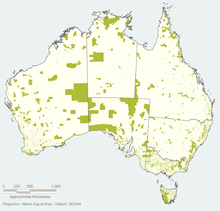Australia's National Reserve System (NRS) is a network of more than 10,000 Commonwealth plus state and territory protected areas which,[1] in combination, on a national scale, protect more than 137 million hectares (340×106 acres), greater than 17% of the continent, of unique biodiversity and most significant ecological landscapes for future generations.[2] The aim of the NRS is protect the diversity of all native landscapes, flora and fauna across Australia through strategic habitat protection. It consists of public, indigenous and privately protected areas of land and inland freshwaters.[3]
| National Reserve System Australia | |
|---|---|
 Sample of Signage, within a Wet Tropics portion of National Reserve System | |
| Established | 1992 |
| Area | > 137 million hectares (340×106 acres) |
| Managing authorities | |
| Website | National Reserve System |

As part of the National Reserve System Cooperative Program, the Interim Biogeographic Regionalisation for Australia framework was developed as a planning tool to assist in identifying areas of priority.[4]
Protected areas on private lands
editPrivately protected areas consist of privately owned areas where owners have entered into "in perpetuity" covenants which are governed by the various legislative Act of the states, territories and commonwealth of Australia.[5] Consequent to these laws, states, territories and commonwealth maintain registers of the lands and their covenants. See for example the NSW register.[6]
History
editThe move by the Australian Government to establish this National Reserve System was triggered by the international Convention on Biological Diversity, as part of the nation's commitment to fulfilling the objectives of that convention.[7] In particular, after signing and ratifying the convention in 1992 the then Prime Minister, Paul Keating, announced [7]
The establishment of a comprehensive system of protected areas is vital if we are to retain our status as a region of megadiversity. Besides being ecologically viable these areas must represent the full range of ecosystems. The Government is committed to the development of a national comprehensive system of parks and reserves. This will be achieved in cooperation with States and Territories.
Within the first 4 years (1992–1996) $11.2 million was spent establishing the system and, with the cooperation and agreement of the Australian States and territories 5,600 properties (covering almost 60 million hectares (150×106 acres)) were included within the system and a new Indigenous Protected Area (IPA) program was initiated to include some of the most valuable and rare ecological landscapes on Indigenous Australian owned lands.[7] 17 Indigenous Protected Area were declared by 2003 which significantly added to the NRS.[8]
Within the next 10 years (1996–2007), with further substantial investment (through a National Heritage Trust) an additional 30 million hectares (74×106 acres) were added to the National Reserve System, two thirds of which were Indigenous Protected Areas. During this time, starting in 1999, Tasmania took a lead investing in partnerships to create protected areas on other private lands; and by 2005 all the states and territories re-affirmed their joint commitment to what was to be described as a national 'flagship in biodiversity conservation'.[7]
The National Reserve System continues to be an Australian Government priority, with continuing funding "target[ing] areas with low levels of protection, including the sub-tropical savanna from Cape York to the Kimberley, the Mitchell grass country of north-west Queensland and arid central Australia;[7] continuing investment in indigenous protected areas;[7] plus a new National Reserve System strategy identifying priorities and actions to be taken over the next 20 years.[9]
Appraisal
editThe NRS has been praised by the WWF Australia as a successful, cost-effective conservation measure.[10] CSIRO modelling has concluded that the NRS will be an important conservation tool to combat the effects of climate change in Australia on the environment.[11]
See also
edit- Indigenous Protected Area
- Protected areas of Australia
- Protected areas of the Australian Capital Territory
- Protected areas of New South Wales
- Protected areas of the Northern Territory
- Protected areas of Queensland
- Protected areas of South Australia
- Protected areas of Tasmania
- Protected areas of Victoria
- Protected areas of Western Australia
- Wild rivers
References
edit- ^ Tony Burke (6 July 2011). "WWF praise for Australia's natural safety net". Media Release. Commonwealth of Australia. Retrieved 3 February 2013.
- ^ Australian Government Department of Environment, Water, Heritage and the Arts "Caring for Our Country: National Reserve System" webpage. Accessed 2 June 2010
- ^ The Natural Resource Management Ministerial Council (2009), Australia's Strategy for the National Reserve System 2009-2030 (PDF), Wikidata Q107258167
- ^ Wearing, Stephen; John Neil (2012). Ecotourism. Routledge. p. 97. ISBN 978-0750641371. Retrieved 3 February 2013.
- ^ James A. Fitzsimons (3 February 2015). "Private protected areas in Australia: current status and future directions" (PDF). Nature Conservation. 10: 1–23. doi:10.3897/NATURECONSERVATION.10.8739. ISSN 1314-3301. Wikidata Q57270770.
- ^ NSW Public register of private land conservation agreements
- ^ a b c d e f Australian Government Department of Environment, Water, Heritage and the Arts "Caring for Our Country: History of the National Reserve System" webpage. Accessed 2 June 2010
- ^ Figgis, Penny (2004). Conservation on Private Lands: The Australian Experience. IUCN. p. 9. ISBN 283170779X. Retrieved 3 February 2013.
- ^ Australian Government Department of Environment, Water, Heritage and the Arts "Caring for Our Country: Strategy for Australia's National Reserve System 2009-2030" webpage. Accessed 2 June 2010
- ^ Victoria Laurie (15 July 2011). "Big success: Australia's protected areas". Australian Geographic. Archived from the original on 30 January 2013. Retrieved 3 February 2013.
- ^ "Major changes needed to protect Australia's species and ecosystems". CSIRO. 18 September 2012. Archived from the original on 8 April 2013. Retrieved 3 February 2013.